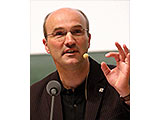Next Generation Information Technology: 'The Atomic Limit?'

Datum: 10.02.2015
Vortrag: Prof. Dr. Dr. h. c. Ulrich Rüdiger
Die stetige Weiterentwicklung der magnetischen Datenspeicherung und des Transistors hat die Informationstechnologie über die vergangenen 60 Jahre maßgeblich geprägt und damit den Einzug in alltägliche Vorgänge geebnet. Über mehrere Jahrzehnte wurde durch konsequente Miniaturisierung die Leistungsfähigkeit der zugrunde liegenden Bauelemente bzw. Konzepte alle zwei Jahre nahezu verdoppelt. Ein weiteres Fortschreiten dieses Integrationsprozesses stößt unweigerlich in wenigen Jahren an physikalische Grenzen der etablierten Technologien, so dass nur die Einführung grundlegend neuer physikalischer Ansätze zur Realisierung von Datenspeicherung und -verarbeitung eine weitere Miniaturisierung zulassen werden. Der Vortrag soll aufzeigen, dass Datenspeicherung und -verarbeitung grundsätzlich auch auf einem atomaren bzw. molekularen Niveau realisierbar sind. Eine experimentelle Demonstration soll dabei beweisen, dass schon heute die Abbildung einer Probenoberfläche mit atomarer Auflösung unter Normalbedingungen im Hörsaal möglich ist.
The continuous further development of magnetic data storage and the transistor design has shaped information technology over the past 60 years and thus paved the way for its application in day-to-day processes. For several decades the efficiency of the underlying components or concepts has nearly doubled every two years due to consequent miniaturisation. Further development of this integration process will be stretched to the physical limits of the established technologies in a few years' time. This means that only the introduction of fundamentally new physical approaches for the realisation of data storage and processing will allow further miniaturisation. This presentation will show that data storage and processing basically is also possible on an atomic or molecular level. An experimental demonstration will show that we can, already today, obtain atomic-resolution images of the surface of a sample under normal conditions in a lecture hall.
Links:
